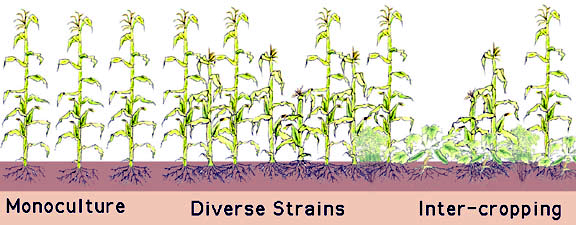traditional vs. conventional


| A comparison of traditional and conventional agricultural models | Traditional craft horticultural production subsistence agriculture |
Conventional intensive industrial agriculture mass production agribusiness |
| Survival of the local community is the goal. Risk aversion: don't put all your eggs in one basket. Provide a constant supply of basic food needs first, then "luxuries." |
Maximization of production and profit based on economic rationality & efficiency. | |
| A belief that the earth is alive, a more gentle manipulation - by hand. | The soil is considered to be dead, intensive mechanized tillage with heavy machinery. | |
| naturally variable rainfall, some irrigation | irrigation | |
| natural organic, fallow time, nutrient cycling, polyculture symbiosis | synthetic petrochemical fertilizer | |
| Diverse seeds are locally developed. Crossbreeding and diversity for risk aversion requires diverse management practices. | Mass produced hybrid seeds are imported. Genetic manipulation and uniformity for maximum yields and standardization of management practices. | |
| natural predators and polyculture resilience | petrochemical pesticides, genetic manipulation | |
| hand weeding, polyculture resilience | petrochemical herbicides, genetic manipulation | |
| Intimate knowledge of the local ecosystem passed down. Skillful but gentle manipulation of the ecosystem. Very labor intensive work at a variety of tasks. | Little specific local knowledge wholesale transfer of "technology" devised and diffused from central point - just read the label, mechanization with fossil fuels replaces most human and animal labor | |
| agroecology: a diverse and complex mixture of plants in balance with the natural environment. resilient, automatically corrects for annual fluctuations, imitation of the environment's flora and fauna makes for a sustainable living system | conventional monoculture: "food production is treated like an
industrial process in which individual plants assume the role of miniature
factories" the individual plant grows in a sterile, stable environment created with massive artificial inputs and energy |
Sources:
Plant illustrations by Mary Frances Jackson
Gliessman, Stephen, 1998, Agroecology: Ecological Processes in Sustainable Agriculture Chelsea, MI; Sleeping Bear Press